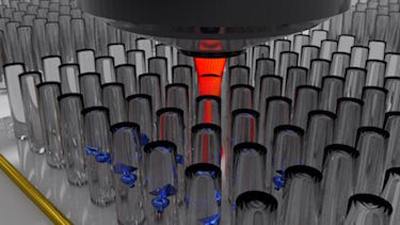
Researchers have recently discovered that silicon carbide (SiC) can host colour centres in which an electron spin can keep its orientation for a long time – a prerequisite for making solid-state quantum bits and nanoscale magnetic sensors.

The colour centre in SiC nanopillars
Silicon carbide is a promising single-photon source and a good material out of which to make quantum bits (qubits) and nanoscale sensors based on individual “colour centres” (luminescing crystal defects that can emit individual photons). A team of researchers in the US, Germany, Korea, Sweden and Japan have now developed the first scalable array of nanopillars containing single-vacancy centres in silicon carbide that can be easily interfaced with an objective or lensed optical fibres. The pillars, which emit light at room temperature, could be used to make quantum nanophotonics platforms for applications in scalable quantum computation and quantum cryptography. They could also serve as single-molecule magnetic sensors.
Researchers have recently discovered that silicon carbide (SiC) can host colour centres in which an electron spin can keep its orientation for a long time – a prerequisite for making solid-state quantum bits and nanoscale magnetic sensors. The material is also widely available since it has been used for decades in power electronics, thanks to its high thermal conductivity and high maximum current density to name but two good properties. It could thus more easily be scaled up to larger systems than competing systems can.
Marina Radulaski, Matthias Widmann and colleagues looked at a polytype (a crystal structure) of silicon carbide called 4H-SiC that contains luminescing defects (or "vacancies"). These defects, which correspond to a missing silicon atom in the crystal, are very much like the defects in diamond known as "nitrogen-vacancy centres" (that form when a nitrogen impurity finds itself next to a missing carbon atom in the diamond lattice).
Long decoherence times
The good thing is that both types of defect form a multi-electron system with a net angular momentum (or spin) that can be split into multiple levels on applying a magnetic field. It can thus be exploited as a qubit. Some SiC vacancies can also be accessed optically and have long decoherence times of at least 160 microseconds at room temperature. Decoherence is the deterioration of spin states as they interact with each other or their environment, and is the bane of anyone trying to make a practical quantum computer.
The researchers made a platform consisting of a matrix of nanopillars containing individual SiC colour centres. They performed their experiment on commercially available 4H-SiC wafers and began by bombarding the material with a beam of energetic electrons to induce damage in the crystal lattice. They then masked the substrate with aluminium and used electron-beam lithography to define a matrix of circles. These were subsequently etched into nanopillars in a reactive ion chamber.
A matrix of single-photon sources or quantum bits
The researchers designed their nanopillars to efficiently guide the colour-centre-emitted light in an upward direction towards an objective or a lensed optical fibre. This approach dispenses with the need for a high collection numerical aperture and greatly reduces the cost of the system.
“Our nanopillar devices are scalable, inexpensive, host colour centres with excellent optical and spin properties at room temperature and can be efficiently interfaced with optical fibres,” Radulaski and Widmann tell nanotechweb.org. “The platform could serve as a matrix of single-photon sources or qubits, both of which are necessary for developing scalable quantum computers and quantum cryptography.”
Single-molecule magnetic sensors too
And that is not all: the pillars can also be used as single-molecule magnetic sensors, say Radulaski and Widmann. Here, the researchers could use electron spin resonance to measure the energy-level structure of the colour centres by taking advantage of the so-called Zeeman effect. This shifts the spin energy levels of the centre to monitor the magnetic fields detected by the colour centres in the SiC.
The international team, which includes scientists from Stanford University, the University of Stuttgart, KIST in Seoul, Linköping University and QST in Japan, is now busy trying to develop new ways to fabricate colour centres in SiC. “We would also like to be able to better control where we can position the centres and are interested in applying our platform to nanoscale magnetic sensing,” say Radulaski and Widmann.